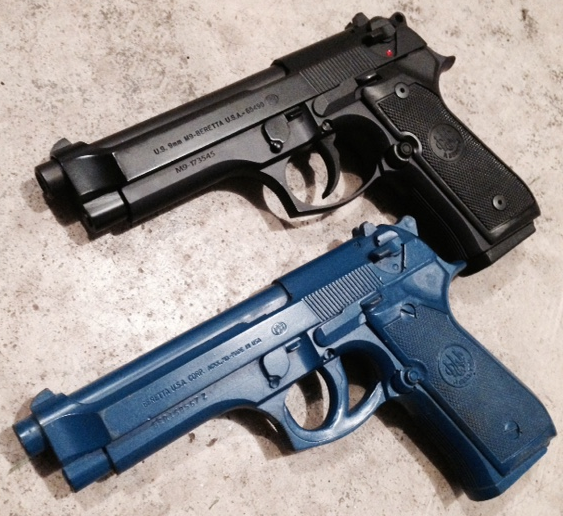
Beretta M9 and its blue pretender showed that even an obvious weight difference would not reliably prevent stress-induced confusion. Photo: author
www.personaldefensenetwork.comNot long ago, I saw a post in an online firearms forum (best advice, all too often: never read the comments!) and followed along as the back-and-forth discussion unfolded. The topic was how to best reload a semi-automatic pistol, particularly if in the middle of a bad situation where we would want that gun loaded in a hurry. A lot of debate bloomed in the short lifespan of that thread, with participants seeming to belong to one of two camps: “Look at the gun” and “Don’t look at the gun.”
Both sides made numerous arguments. The “Don’t look” faction said, among other things, that loading a pistol is a very simple mechanical task, and after moderate repetition, it can be done without the need for any visual reference. After all, it was pointed out, none of us look down at our brake pedal to stop the car, do we? This allows our full attention to remain on the threat and everything else that’s going on around us. For their part, the “Look” party quite reasonably opined that the gun is right there, in your immediate field of view, so why not pay attention to what you’re doing and reduce the risk of screwing it up?
The reason I bring this up is to share the results of an informal experiment I recently concluded, in the hope that it can be of some use to anyone who might be interested in figuring out which end of the “Look/Don’t look” conundrum they might be on.
Home-Defense Handgun Drills
It all started about three years ago, when it dawned on me that I was seeing the same inexplicable behavior—under the same conditions—over and over again. The conditions were: during the live-fire exercise of a Home-Defense Handgun class, the students are run, one at a time, through what we call our “final scenario” drill. This drill is designed to force the student to multitask. Using the information given, the student goes through the steps of responding to a home intrusion, which includes retrieving their defensive handgun from a locked quick-access safe and loading it.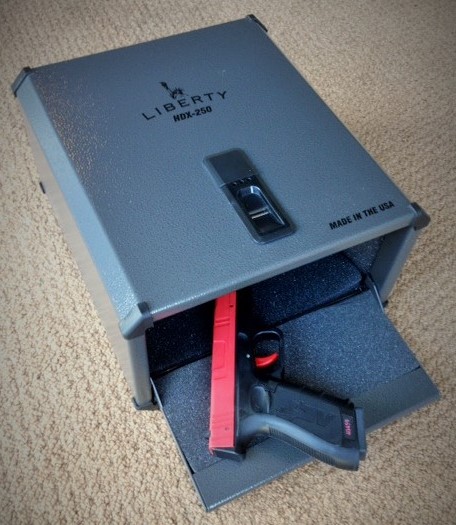
Home Defense Handgun course utilizes quick-access safes like this biometric unit from Liberty Safes, here with excellent SIRT training pistol. Photo: author
www.personaldefensenetwork.comAlso, it gives me an opportunity to make the exercise as challenging as possible for everyone. In this kind of open enrollment class, we typically have a variety of skill and experience levels training together. For those who are relatively new to defensive shooting, the final scenario drill itself is pretty taxing with nothing extra thrown in. But the more seasoned shooter often needs help to reach that same level of confusion and stress—and I am happy to oblige!
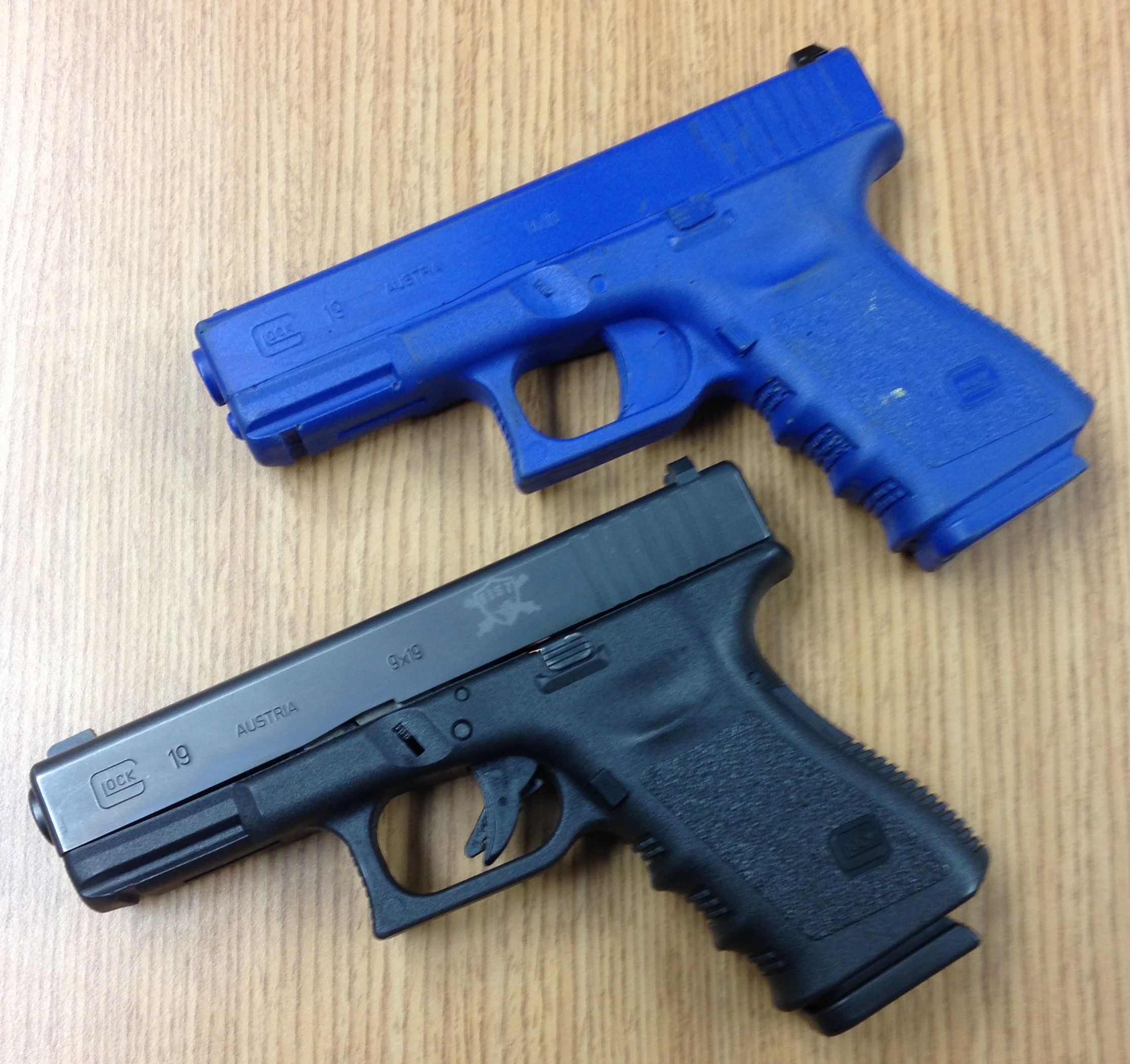
Glock 19 and blue gun clone. Photo: author
www.personaldefensenetwork.comBlue Gun Surprise
For example, I might move their magazines to a different spot on a table full of items, which forces the student to pause their memorized routine and find them. Every so often, a student opens the quick-access vault and discovers that their pistol has been field stripped—surprise!—another unexpected disruption. And then there is my personal favorite and the source of our topic today: the student reaches into the vault for their pistol but their hand emerges holding a completely non-functional replica of their firearm, known in the business as a “blue gun.” And here the fun begins, because the inexplicable behavior I began to see happen over and over again is this: they try to load the blue gun. Because the blue gun is a solid lump of molded polymer, a magazine cannot be inserted, and it bounces off the bottom of the grip with a clunk. This failure seems to automatically trigger a second attempt and sometimes a third. But the astonishing thing is that during this process, these students are all staring straight down at the gun! Which caused me to ask, “Why is this happening?”I started by asking those students why they kept trying to shove a magazine of live ammunition into what was quite obviously not their pistol. In so many words, they all responded that they recalled “fumbling” the load and not noticing the blue gun until they looked at it, with the entire elapsed time being the blink of an eye. Fair enough, I say, except that you were looking directly at it the entire time, and it went on for several seconds, not the fraction of a second that you remember. Obviously, there is something else at work.
How the Brain Works
To find that something else, I visited my local public library. (Yes, people still do that.) I was hunting for books on neuroscience, preferably in layman’s terms. After all, I want to understand and apply what I learn, not be reminded that I have no background in the finer details of neuroscience. Thankfully, among the stacks I located a copy of The Brain—The Story of You by Dr. David Eagleman. Suffice it to say that Dr. Eagleman’s credentials as both a neuroscientist and an author are rock-solid. I found the book to be a fascinating glimpse into the inner workings of the human brain and thoroughly enjoyed the read. More to the point, I believe I found what I was looking for.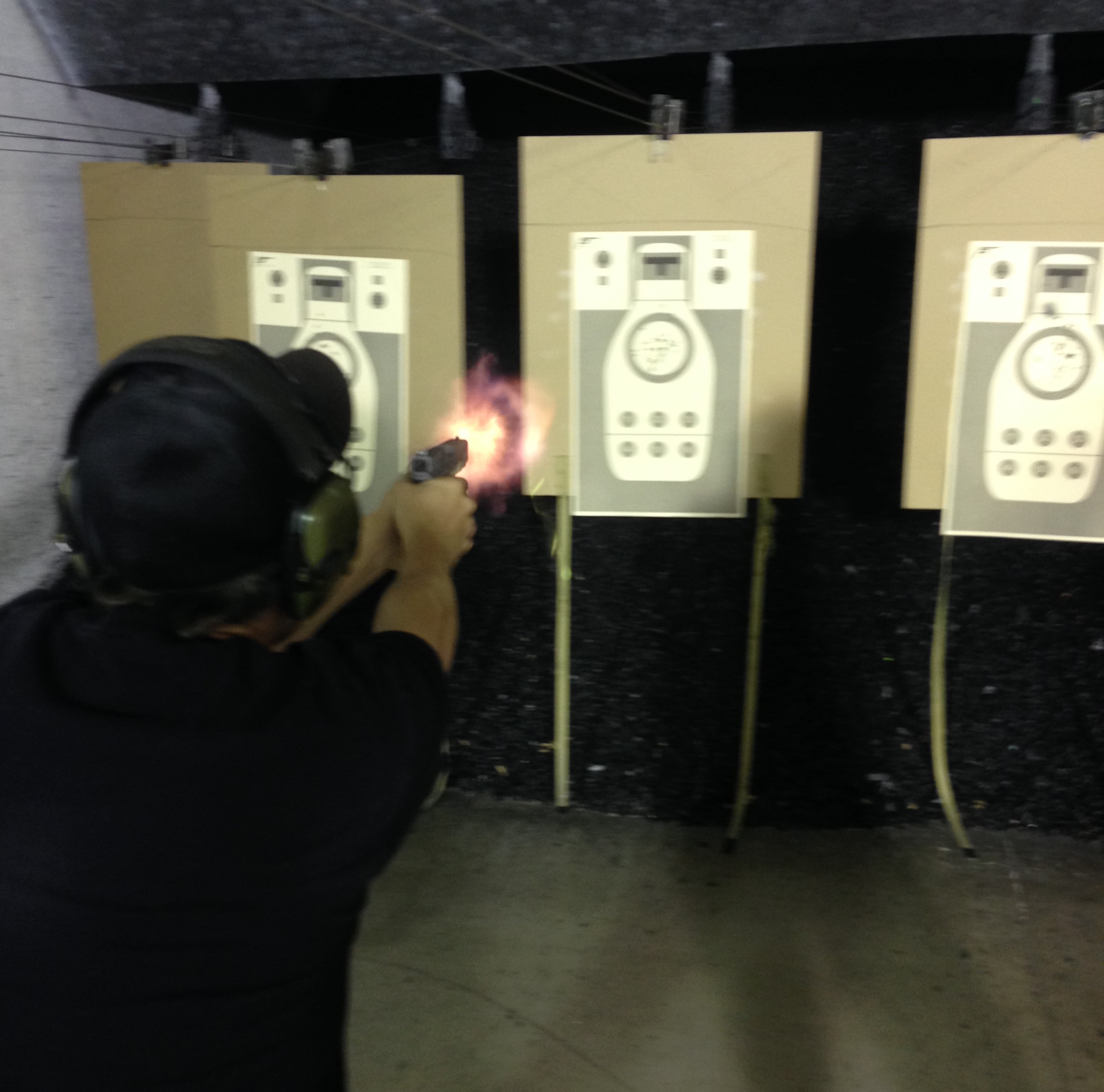
Understanding more about how the brain works can help inform all facets of our self-defense training. Photo: author
www.personaldefensenetwork.comIn simple terms, it is easy for us to imagine our eyes as windows, and that our brain is looking out through them, as though peering through a pair of binoculars. In reality, our brain is a reclusive prisoner, trapped in a windowless dungeon. The brain has no contact with the world around it whatsoever. It can only interpret electrochemical signals from the various sensory inputs, creating an image of what it believes is out there. It is kind of unsettling to ponder that such familiar things as color, odor, and taste don’t actually exist in the outside world. They are creations of the brain, which is constantly at work building a model of the outside world, and modifying it based on the relentless flood of sensory data coming in.When it comes to vision, it gets complicated. The brain never actually “sees” anything. It can only compare the input from the senses and make an educated guess at what is in front of it. This sensory information becomes part of the brain’s internal model, while simultaneously playing on the big screen of the mind.
All of this works well enough until stress is added into the mix. The constant absorption and processing of sensory information require lots of energy. Strenuous physical effort, especially the unexpected surge of adrenaline in fight-or-flight survival mode, also demands tremendous energy. This reallocation of energy resources is part of why the brain and body act differently when kicked into survival mode. Under stressful conditions, the brain is likely to rely more on its internal model and less on real-time input. This is why we are less observant when we are in a hurry. We get the picture, so to speak, but don’t get a lot of the details.
A working theory is easy to establish: under the (admittedly minor) stress of the drill, some students reach into the safe and grasp what appears to be their pistol. Tactile sensory information from the surface of the hand reports a familiar shape and texture. The brain’s interior model pulls up a picture of the gun based on both the expectation that the gun is there and the confirmation coming from the hand. This done, the brain moves onto the next task. And even though the hand has now withdrawn from the safe and is holding the object within the field of view, the information coming in from the eyes has been briefly assigned a lower priority.
In this way, the brain does not notice the blue gun—it “sees” the actual gun it expects to be there. A mental alarm bell is triggered at some point only after the magazine fails to behave as expected. This new development shuffles the neural deck again, and the brain focuses on the problem. Visual input is now back in the driver’s seat, and the brain recognizes that the blue gun is not a real gun.
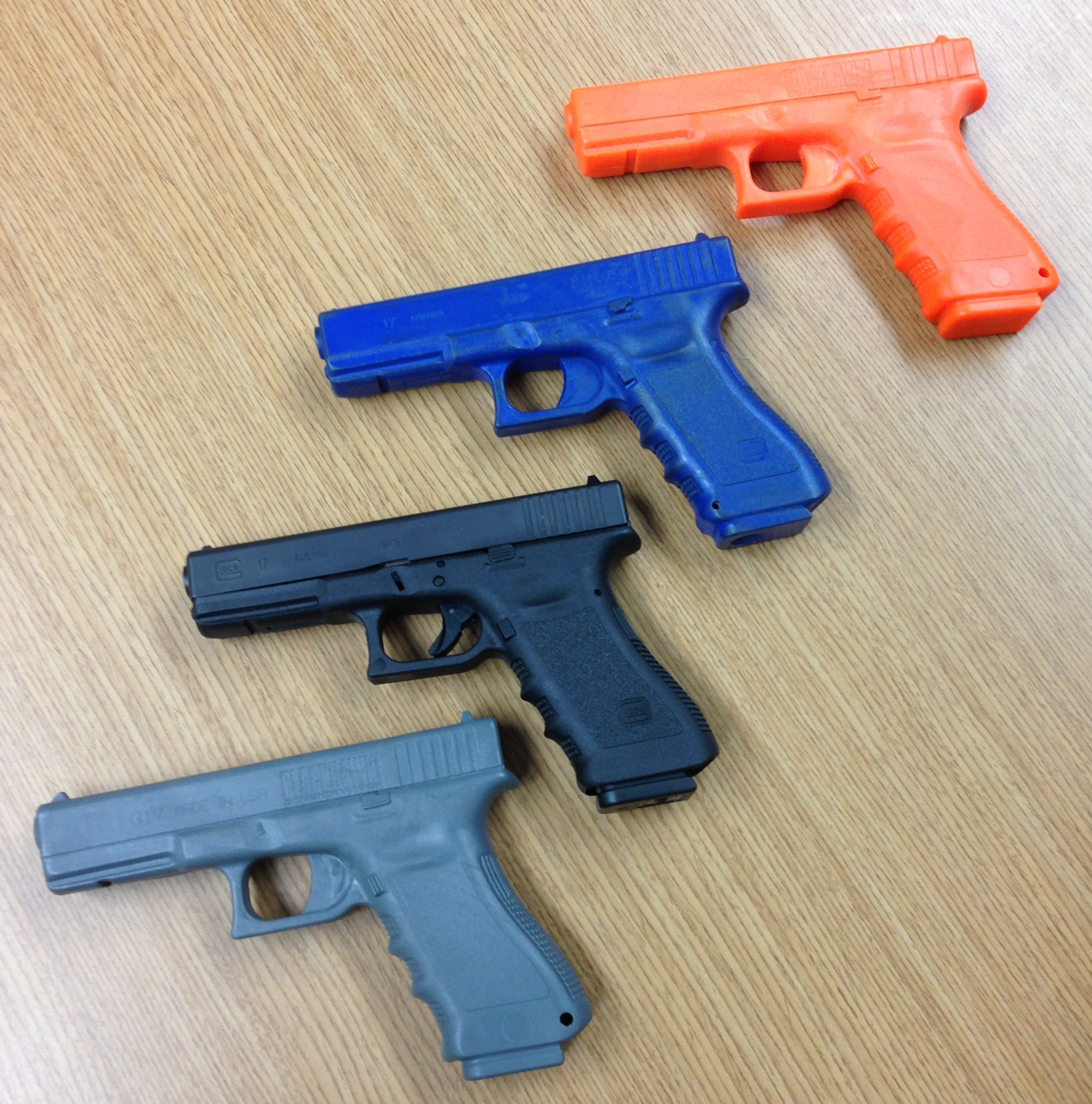
Glock 17 alongside a host of imposters. Color seemed to make no difference in my experiments. Photo: author
www.personaldefensenetwork.comResults of Experiments
With this in mind, I was able to run some quick experiments over time with students in the class and unsuspecting co-workers who were helping me “rehearse” the drill. Although I don’t in any way claim to have done the work of a real researcher, I did observe the following consistencies:REALITY: If the blue gun was not an exact match for the exterior surface of the real gun, the brain was less likely to be fooled. I generally only used the blue-gun trick when I had the opportunity for a match, most often a third-generation Glock 17. They show up in class frequently and I have several blue guns. Attempting to use a similar but different gun, e.g. a Springfield Armory XD compact blue gun replacing a real service-size XD9, didn’t fool anybody.
COLOR: Color appears to be irrelevant, which supports the idea that the student doesn’t see what they’re actually looking at. At various times, I used blue guns that were gray, sky blue, and even fluorescent orange, and all were mistaken for the real thing during the drills.
WEIGHT & HEFT/OVERALL FEEL: Inconclusive, but probably important. I had one opportunity to substitute a full-size 1911 blue gun for the real thing because they wore identical grips. The student paused with their hand in the safe and looked over at me, knowing that what they were touching was not their gun. Two attempts at fooling students using the Beretta 92 FS resulted in a draw: one was fooled and tried to load the blue gun, and the other was not. So, two out of three recognized the deception when their large, heavy, metal-framed guns were replaced with plastic models. It seems that polymer-framed guns are more likely to be confused.
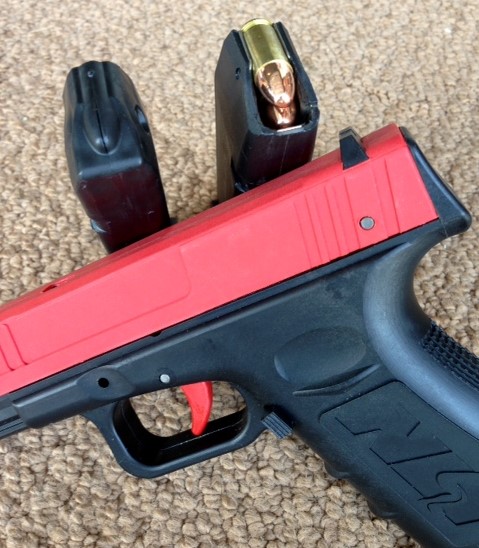
SIRT training pistol magazine alongside actual Glock 17 magazine loaded with ball ammunition. Not similar enough to trigger a confusion response. Photo: author
www.personaldefensenetwork.comEXPERIENCE/EXPOSURE: During these drills, it seemed that those students who were very experienced at gun handling were the ones most likely to suffer from blue gun confusion. This again would lend support to the overall hypothesis that the brain was relying more on the combination of familiarity and tactile confirmation instead of vision. Find a gun-shaped lump of molded polymer where one expects to find a gun made of molded polymer, and the confusion is almost inevitable.
Conclusions
But as fascinating as all of this might be… is it of any use to us as people who are interested in becoming as efficient as we can be using our chosen tools of defense? After all, the magazine being separated from the pistol is a contrivance of the specific drill, not what I would expect or recommend for actual home defense. Nor is it reasonable to assume I will come creeping along some night and sneak a blue gun into your quick-access safe (You do use one, don’t you?). So, other than showing how much fun I have teaching Home-Defense Handgun courses at Black Wing Shooting Center and how obnoxious it can be to attend that class, is there any take-home value to these observations?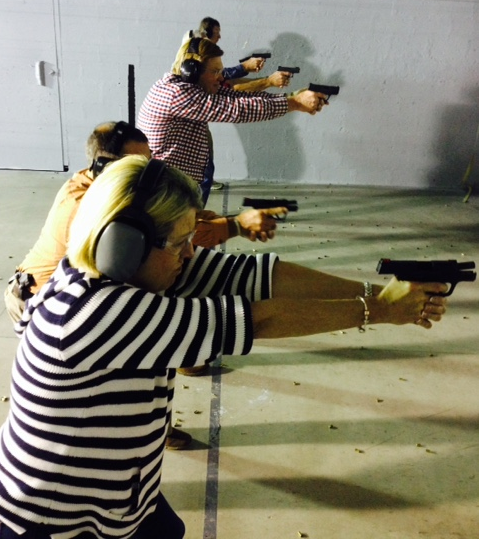
In the end it's all about understanding ourselves and learning how to best prepare for the absolute worst-case scenario. Photo: author
www.personaldefensenetwork.com
The biometric quick-access safes i tried were not reliable, so I won't waste money, nor trust another one.
In California, where only CA-approved handguns and 10-or-fewer round magazines are legal, it will be absolutely necessary to reload in an extended firefight (unless you're James Bond). Having 2 (or more) pistols nearby is the simple-minded solution. This tactic is just an extension of the famous 2-sword style of fighting exemplified by the famous samurai Miyamoto Musashi.
From a different perspective--as a baseball coach I spent a lot to effort to get my players to keep their eyes on the target. But the key is to know what the target is. Before the ball is caught (or hit) the ball is the target. The player has to look the ball into his glove. After an infielder has caught the ball and got it in his throwing hand, then the target is the first baseman's glove. The runner is not the target. A player making a play on a ground ball has a severe temptation to look at the batter running to first base instead of his target, which is the ground ball that he needs to catch before he can make the throw. Hitters also try to "sneak a peek" at where they want to hit the ball instead of keeping their eyes (both eyes) on the incoming pitch. In both cases looking away for the briefest instant pulls the glove or bat off the ball and the result is a miss. You wouldn't believe how quickly this works--looking away at the last instant, when they tell themselves that they've got it, they still pull the glove or bat off the ball. Little-leaguers do it and major-leaguers do it. The principle is: You go where you look. During the reloading of a pistol, the target is not the aggressor, it's the mag well. So I turn the pistol grip to the horizontal position (palm up) so I can see where the mag is supposed to go, and do the reload. I can ascertain that the bullets are pointed forward (so I don't shoot myself) while I insert the mag. In my mind, this is better than what I've seen so often on the baseball field (where the moves are also complex and stress is a factor). I've watched infielders felling around their feet for the bobbled ball while they watch the runner. I've seen outfielders miss an easy ground ball while watching the runner. So in my opinion, look at what you're doing. You go where you look.
I agree with your position about a stored handgun with inserted magazine but empty chamber. Makes sense. Regards neuroscience: Yes, but it may be needless complication -- "If it walks like a duck.......... I think that, just like our forefathers, we can learn to defend ourselves effectively without having to interpret esoteric experiments. I would suggest the big problem is with the emphasis on speed.....the kind of speed that wins competitions, not necessarily gun fights. I have always placed my emphasis on doing the right thing rather than making some blindingly fast athletic manoevre. To my brain, therefore, a blue pistol is just that. I may be "slower" but I am confident I will be able to, calmly, take care of stress and the bad guy.
Navy Vet here. What I was taught in the Navy about shooting a pistol, repetition, familiarity, is what it takes ( I guess they call that muscle memory nowadays). If you are used to handling your weapon, you will be able to handle it in stressful situations.
I have seen similar confused responses when qualifying department personnel on our range. I once watched an officer make several gallant attempts to insert a can of OC pepper spray into their handgun when they pulled Liquid Jesus out of a pouch rather than one of several 17-round magazines that were in the next pouch to the right. The can of OC Spray does not even closely resemble a Glock 17 magazine in look, shape, weight, or feel, yet the officer made at least three attempts to insert it into the magazine well. this is why we tell shooters to visually AND physically check that a firearm is clear and safe: the brain sees what it expects to see. This officer expected to see and feel a pistol magazine and it took a few seconds to figure out they did not have a magazine in their hands. To be fair, this officer was an average shooter: not the best shooter but far from the worst. My point is still valid, however. Shooters often do not accurately perceive basic, yet very important, things about the condition of their firearm, their environment, and the like when under little or no stress, so why would we teach them to gamble their lives on something as important as reloading their pistol under fire? Yes, officers (and civilian shooters) need to spend more time on the range training, but that applies to almost all of us. We could ALL spend more time, money, and effort training...and then life intervenes. We all have families, bills, etc. that force us to prioritize what we do. So, assuming most of us aren't pro shooters, Delta, DEVGRU, Range, Recon types, we do the best we can do and adjust our tactics and techniques accordingly. I say again, using your eyes to aid the reload makes sense . I've endured several arguments about looking vs. not looking at your pistol during combat reloads (tactical and when in slide-lock). In my humble opinion, bringing the pistol up where you can see it and using your eyes to aid during the reload is a safer bet than doing it "blind" and hoping you don't muck it up under the extreme stress of being under fire. I have never been involved in an OIS, but I have come very, very close several times and I know a little something about how adrenaline affects your motor skills. Aside from that, I have spoken to several competition shooters and combat vets from various elite units (SF, Tier 1, national SWAT teams, etc.) and that is what they teach, preach, and live. One of the arguments I've heard from the "no look" crowd is that reloading blind, allows the shooter to keep an eye on the threat(s) while the reload is being conducted; in other words, better situational awareness leads to quicker target acquisition after the reload. I call BS on that. I've seen too many people fumble a reload while trying to track one threat (much less multiple threats) while they're moving, their partner is moving, the threats are moving, and they're trying to issue commands. We can only perform one complex task at a time (and reloading is a complex task involving decision making, the use of multiple limbs, spatial awareness, fine motor skills, etc. Look, if you can reliably reload your pistol under fire "blind", God bless you. The rest of us mere mortal have to stack the deck in our favor and use our eyes, however briefly, to ensure we are not trying to load a can of pepper spray (and that the pointy part of the bullets is facing forward - seen that too). Stacking the deck comes weeks, months, years before the gunfight ever occurs: We should routinely check our gear and ensure it is set up properly. We need to spend meaningful and quality training time getting the repetitions practicing reloads (using our eyes) until some of the movements become second nature. My two cents (actually 0.3 cents adjusted for inflation).
These were very good recomondations for stirring and loading a handgun with a magazine but what about recommendations for a revolver for when needed in a hurry
Wow, just saw where my reply to a comment is awaiting “moderation”. Done here
I've never been a gun person, but the way things are now in a country where I once felt relatively safe, find myself widowed and all alone. So I recently purchased a 9mm and I have a horrible time trying to reset the gun and trying to load the cartridge with the bullets as I don't have enough strength in my hands & fingers. I finally loaded the cartridge after purchasing a fast loader accessory, but pulling the gun reset back & loading is all but impossible for me and I don't know how to make this right.
I think you're looking at yet another result of the current emphasis on speed in defensive firearm training. Like an athlete lining up for the 100m sprint, the priority is often on meeting speed demands, not necessarily on overall efficient performasnce. This makes speed a powerful stressor and interferes with "secondary" considerations, like checking that the firearm is functional. The old saying that "Haste makes waste" or "More haste less speed" recognized this long before we had neuroscience. What was traditionally planned was that FIRST the action would be done right THEN a secondary emphasis could be placed on NOT wasting time. The difference between speed gained by being efficient and a direct attempt to go fast may be what you are wrestling with? For me, I'd rather take a few seconds (nanoseconds?) to make sure I have all my ducks in a row than find I have a plastic pistol in my hands.......